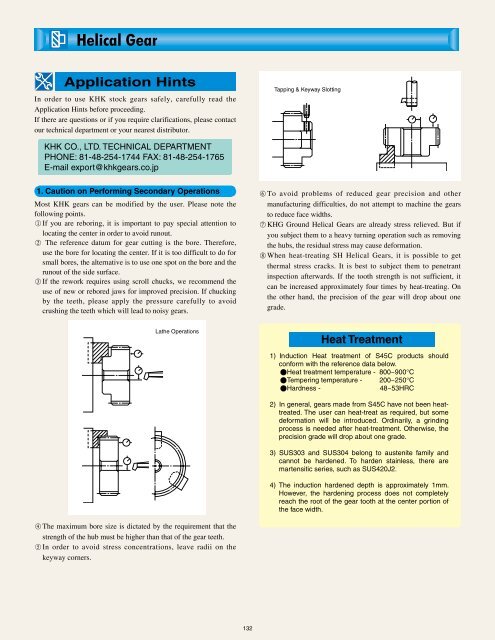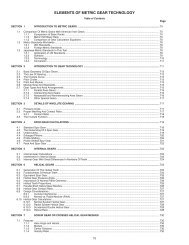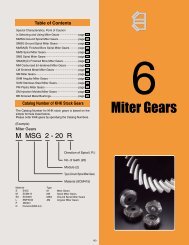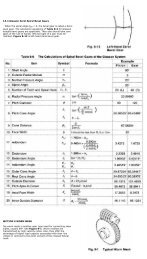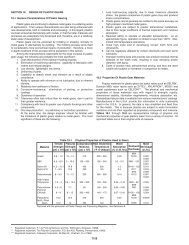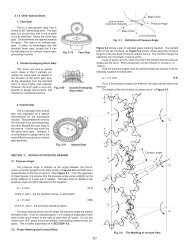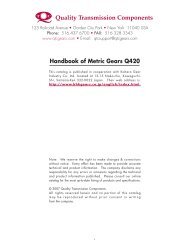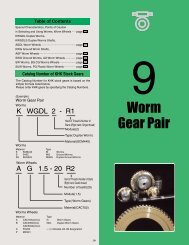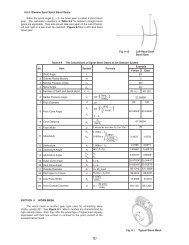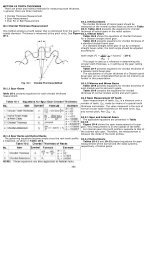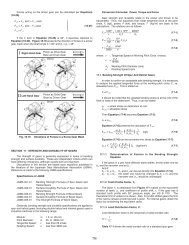Section 2. - Helical Gears
Section 2. - Helical Gears
Section 2. - Helical Gears
Create successful ePaper yourself
Turn your PDF publications into a flip-book with our unique Google optimized e-Paper software.
<strong>Helical</strong> Gear<br />
Application Hints<br />
In order to use KHK stock gears safely, carefully read the<br />
Application Hints before proceeding.<br />
If there are questions or if you require clarifications, please contact<br />
our technical department or your nearest distributor.<br />
KHK CO., LTD. TECHNICAL DEPARTMENT<br />
PHONE: 81-48-254-1744 FAX: 81-48-254-1765<br />
E-mail export@khkgears.co.jp<br />
1. Caution on Performing Secondary Operations<br />
Most KHK gears can be modified by the user. Please note the<br />
following points.<br />
1 If you are reboring, it is important to pay special attention to<br />
locating the center in order to avoid runout.<br />
2 The reference datum for gear cutting is the bore. Therefore,<br />
use the bore for locating the center. If it is too difficult to do for<br />
small bores, the alternative is to use one spot on the bore and the<br />
runout of the side surface.<br />
3 If the rework requires using scroll chucks, we recommend the<br />
use of new or rebored jaws for improved precision. If chucking<br />
by the teeth, please apply the pressure carefully to avoid<br />
crushing the teeth which will lead to noisy gears.<br />
6 To avoid problems of reduced gear precision and other<br />
manufacturing difficulties, do not attempt to machine the gears<br />
to reduce face widths.<br />
7 KHG Ground <strong>Helical</strong> <strong>Gears</strong> are already stress relieved. But if<br />
you subject them to a heavy turning operation such as removing<br />
the hubs, the residual stress may cause deformation.<br />
8 When heat-treating SH <strong>Helical</strong> <strong>Gears</strong>, it is possible to get<br />
thermal stress cracks. It is best to subject them to penetrant<br />
inspection afterwards. If the tooth strength is not sufficient, it<br />
can be increased approximately four times by heat-treating. On<br />
the other hand, the precision of the gear will drop about one<br />
grade.<br />
Lathe Operations<br />
Heat Treatment<br />
1) Induction Heat treatment of S45C products should<br />
conform with the reference data below.<br />
●Heat treatment temperature - 800~900°C<br />
●Tempering temperature - 200~250°C<br />
●Hardness -<br />
48~53HRC<br />
2) In general, gears made from S45C have not been heattreated.<br />
The user can heat-treat as required, but some<br />
deformation will be introduced. Ordinarily, a grinding<br />
process is needed after heat-treatment. Otherwise, the<br />
precision grade will drop about one grade.<br />
3) SUS303 and SUS304 belong to austenite family and<br />
cannot be hardened. To harden stainless, there are<br />
martensitic series, such as SUS420J<strong>2.</strong><br />
4) The induction hardened depth is approximately 1mm.<br />
However, the hardening process does not completely<br />
reach the root of the gear tooth at the center portion of<br />
the face width.<br />
4 The maximum bore size is dictated by the requirement that the<br />
strength of the hub must be higher than that of the gear teeth.<br />
5 In order to avoid stress concentrations, leave radii on the<br />
keyway corners.<br />
132


